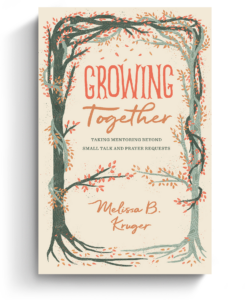Few people enjoy reading the fine print. I lament that Bible cross references are overlooked. Packed into the margins in a miniscule font, they strike many modern readers as tedious. They’re not the flashiest tool, compared to Bible apps that reward consistent reading with streaks and milestones, or videos that unpack passages.
But cross references deserve more credit as allies in helping us treasure God’s Word. Here are a few reasons why.
Tributaries of Truth
Cross references are like tributaries, showing us how other verses in the Bible flow into and from the verse we’re reading. They pull us above the canopy into open skies, where we can look down with wonder at how themes, promises, and events develop in Scripture. They help us not miss the forest for the trees. Criss-crossing across the landscape of Scripture, these references remind us that God’s plans are never abandoned, nor his promises compromised.
Cross references are like tributaries, showing us how other verses in the Bible flow into and from the verse we’re reading.
I’m amazed to know that the water I drink in Southern California partially originates in the mountains of Wyoming and Colorado, traveling hundreds of miles via natural processes and human engineering before reaching my faucet. Similarly, when I look up a cross reference and discover how God orchestrated a moment recorded in Scripture, or fulfilled a promise, I’m awestruck by his providential plan.
As a quick example, John 1:29 records John the Baptist declaring Jesus the Lamb of God. This title wasn’t coincidental—it was a nod to a trove of Old Testament history and theology.
By looking up a few cross references for John 1:29 in my Bible, I’m reminded that Jesus’s identification as a “lamb” is linked to Abraham’s willingness to sacrifice Isaac (Gen. 22:8), Isaiah’s description of the suffering servant slaughtered like a lamb (Isa. 53:7), and the angelic chorus worshiping Christ as the lamb who was slain (Rev. 5:12). These connections matter, and cross references ping our theological memories.
Text-Tethered Exploration
Cross references also train us to study the Bible for ourselves, without over-relying on external resources. As Jen Wilkin points out, when devotional resources do the heavy exegetical lifting for us, our ability to wrestle with the meaning of the text atrophies (or never rightly develops).
While study Bibles, commentaries, videos, and sermons are helpful, let’s learn to prepare our spiritual meals using only the ingredients of the Bible. In our devotions or teaching prep, looking up cross references keeps our eyes in the text, and often provides context and clarity before we consult our pet theologians. We all need the accountability and wisdom of the saints who came before us, but not at the expense of exploring the Bible.
Learning to Linger
Discovery takes discipline. As people who rely on efficient digital fact-finders (Siri, Alexa, Google), we struggle with this. We expect wisdom to be insta-delivered, with minimal effort, rather than the fruit of vigorous pursuit (Prov. 2:1–5; Ps. 1:1–2).
Cross references slow us down, sparking reflection and critical thinking, as we explore connections between passages. They’re marks on the map that show where treasure can be excavated—but they leave the digging to us. It’s tragic to think how many profound insights we miss because we’re too hurried to follow a meandering trail across the sprawling pages of Scripture. Cross references can help us fight for more extended time in the Word.
Three Simple Tips
Looking up cross references has invigorated my personal Bible reading. Here are three simple habits I’ve cultivated that make it fun and fruitful.
1. Less Is More
Looking up cross references might seem overwhelming—are we supposed to devote hours to this? No, in fact I’ve never looked up every reference on a page of my Bible, nor would I suggest this to anyone starting out. Whatever your daily regimen of Bible reading, look up one or two cross references each day. Start small.
2. Mine the Gems, Chase the Mysteries
How do we sift through the dozens of cross references we could look up without succumbing to decision fatigue? I like to mine the gems—in other words, when something in a passage stands out, moves me, or sparks interest, I look it up. Start there. If something is puzzling or ignites curiosity, I’ll take the time to check out a cross reference or two.
All Scripture is treasure, but the Holy Spirit often illuminates specific words or verses while we read. When something stands out, look it up.
3. Leave a Trail
As Tony Reinke recommends in Lit!: A Christian Guide to Reading Books, I love writing in my Bible. When I look up a meaningful cross reference, I often write the reference right next to the verse. That way, the next time I’m reading that verse, my handwritten notation jumps off the page to remind me: “Don’t forget what you discovered! This verse connects to that verse.”
In essence, I leave myself a handwritten trail log of where I’ve been, and what I learned from fastening one portion of the Bible to another. It multiplies my efforts, allowing me to access earlier learning easily.
As the maxim says, sometimes the best gifts come in small packages. Don’t ignore the minute markings stacked along the borders of your Bible pages—for the willing sleuth they’re a tool to increase your knowledge and joy.
Involved in Women’s Ministry? Add This to Your Discipleship Tool Kit.
 We need one another. Yet we don’t always know how to develop deep relationships to help us grow in the Christian life. Younger believers benefit from the guidance and wisdom of more mature saints as their faith deepens. But too often, potential mentors lack clarity and training on how to engage in discipling those they can influence.
We need one another. Yet we don’t always know how to develop deep relationships to help us grow in the Christian life. Younger believers benefit from the guidance and wisdom of more mature saints as their faith deepens. But too often, potential mentors lack clarity and training on how to engage in discipling those they can influence.
Whether you’re longing to find a spiritual mentor or hoping to serve as a guide for someone else, we have a FREE resource to encourage and equip you. In Growing Together: Taking Mentoring Beyond Small Talk and Prayer Requests, Melissa Kruger, TGC’s vice president of discipleship programming, offers encouraging lessons to guide conversations that promote spiritual growth in both the mentee and mentor.

































